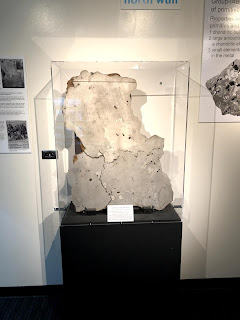For my first event I attended the meteorite gallery on the UCLA campus located in the geology building. I had heard about this previously from my oceanography teacher so when I saw it in this class I knew it must be worth a visit. Although it isn't a very big space, they fit a lot of information into one space. In this small area I was truly able to see the two cultures of science and art collide. We had learned about this separation in the first week but quickly realized there was nothing separate about the two. With art comes science and with science comes art.
One of the pieces that stood out the most to me was the "old woman iron meteorite". It is the second largest meteorite from the USA with a mass of 2753 kg. The mass of the slab shown was only 80.5 mg. With this piece of art being on long-term loan from the Smithsonian it is something special. To think that the slab being shown is only a small part of what was found is incredible. Know it is on display for students to observe and learn from. Nature and science can be turned into art just by the display and perspective. The unusual structure occurs from the slow cooling of metal with 5.5% Ni followed by shock alteration and recrystallization.
I would recommend this gallery to any UCLA student. This combination of the two cultures of art and science is right under our noses. It doesn't take long to even poke your head in and see what beauty these meteorites have to offer. Next time you are near the geology building, take the extra time to go. I promise it is worth your time.



Comments
Post a Comment